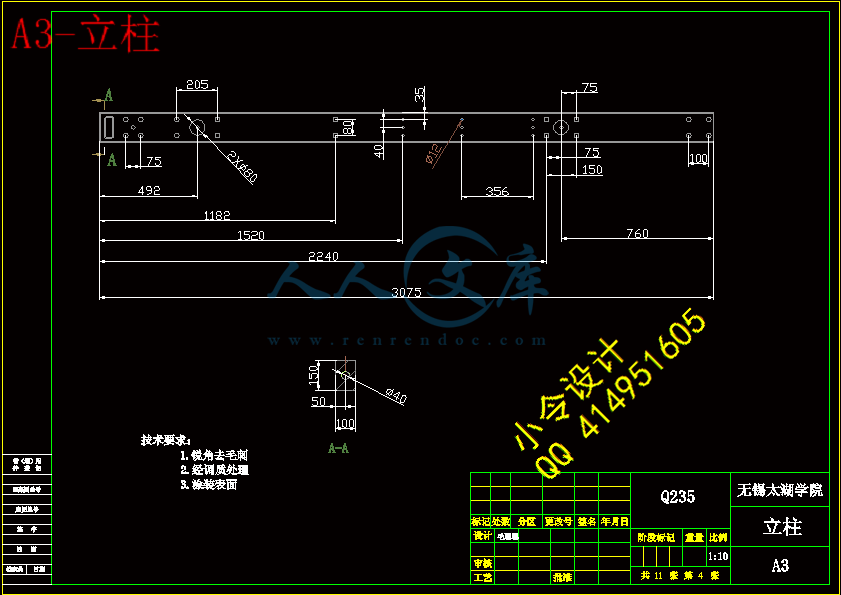【温馨提示】 购买原稿文件请充值后自助下载。
[全部文件] 那张截图中的文件为本资料所有内容,下载后即可获得。
预览截图请勿抄袭,原稿文件完整清晰,无水印,可编辑。
有疑问可以咨询QQ:414951605或1304139763
摘 要
100吨非液压式冲床是通过偏心拉杆滑块机构将电动机的旋转运动转换为滑块的直线往复运动,对坯料进行成形加工的锻压机械。100吨非液压式冲床动作平稳,工作可靠,只用于冲压模型工艺。其结构简单,操作方便,性能可靠。
100吨非液压式冲床主要用于电子、通讯、电脑、家用电器、家具、交通工具(汽车、摩托车、自行车)五金零部件等冲压及成型。
冲床的设计原理是将圆周运动转换为直线运动,由主电动机出力,带动飞轮,经离合器带动齿轮、曲轴(或偏心齿轮)、偏心拉杆等运转,来达成滑块的直线运动,从主电动机到偏心拉杆的运动为圆周运动。
关键词:压力机;偏心拉杆机构;机械制造;设计原理
Abstract
100 tons of non-hydraulic punch through the eccentric rod slider mechanism of the rotary motion of the motor is converted to linear reciprocating motion of the slider, the blank forming forging machinery. 100 tons of non-hydraulic punch is smooth, reliable, only for stamping model process. Its structure is simple, easy to operate, reliable performance.
100 tons of non-hydraulic press is mainly used for electronics, telecommunications, computers, household appliances, furniture, vehicles (cars, motorcycles, bicycles) metal parts stamping and forming.
The design principle of the punch convert circular motion into linear motion output by the main motor, flywheel, clutch drive gear, crankshaft (or eccentric gears), eccentric lever operation to achieve linear motion of the slider from the main motor to the eccentric lever movement circular motion.
Key words: pressure machine; crank organization; machine manufacturing; the design principle
目 录
摘 要III
ABSTRACTIV
目 录V
1 绪论1
1.1 本课题研究的科学意义1
1.2 冲床的发展史及国内外的发展概况1
1.3 本课题的主要内容2
2 电动机的选择和飞轮设计3
2.1 冲床电力拖动特点3
2.2 电动机的选择3
2.2.1 选择电动机的类型3
2.2.2 选择电动机的功率3
2.2.3 确定电动机的转速3
2.2.4 计算总传动比和分配传动比4
2.2.5 计算传动装置的运动和动力参数4
2.3 飞轮转动惯量及尺寸计算5
2.3.1 冲床一次工作循环所消耗的能量5
2.3.2 飞轮转动惯量计算6
2.3.3 飞轮尺寸计算7
2.3.4 飞轮轮缘线速度验算7
3 机械传动系统9
3.1 传动系统的类型及系统分析9
3.1.1 传动系统类型9
3.1.2 传动系统的布置方式9
3.1.3 离合器和制动器的位置9
3.1.4 传动级数和各级传动比的分配9
3.2 齿轮的设计9
3.2.1 高速级齿轮设计9
3.2.2 低速级齿轮设计12
3.3 输出轴的设计14
3.3.1 轴的概述14
3.3.2 输出轴设计计算15
3.4 平键连接的设计19
4 偏心拉杆滑块机构20
4.1 偏心拉杆滑块机构的运动与受力分析20
4.2 偏心轮的设计计算21
4.2.1 偏心轮机构的特点与应用21
4.2.2 偏心轮的结构示意图21
4.2.3 确定偏心轮的基本参数21
4.3 偏心拉杆装置22
4.3.1 偏心拉杆的结构22
4.3.2 偏心拉杆的强度校核23
4.4 轴承的选择29
4.4.1 轴承概述29
4.5 滑动轴承30
4.5.1 滑动轴承的润滑及轴瓦结构30
4.5.2 滑动轴承的计算30
5 离合器与制动器31
5.1 离合器与制动器的作用原理31
5.2 离合器的设计31
5.2.1 离合器的选择31
5.2.2 双转键离合器的结构31
5.3 制动器的设计32
5.3.1 制动器的类型、工作特性及其选择原则32
5.3.2 带式制动器的结构32
6 过载保护装置设计33
7 电路控制35
7.1控制电器与执行电器的选择35
7.2 线路的设计36
8 润滑系统37
8.1 冲床常用润滑剂37
8.1.1 稀油润滑37
8.1.2 干油润滑37
9 结论与展望38
9.1 结论38
9.2 不足之处及展望38
致 谢39
参考文献41
1 绪论
1.1 本课题研究的科学意义
100吨非液压式冲床是采用偏心拉杆机构作为工作机构的锻压机器。具有开式机身,与闭式冲床相比有其突出的优点:装模具和操作都比较方便,同时为机械化和自动化提供了良好的条件。但是也有其缺点:工作时变形较大,刚性较差。这不但会降低制品精度而且由于机身有角变形会使上模轴心线与工作台面不垂直,以至破坏了上、下模具间隙的均匀性,降低模具的使用寿命。
冲床是板料冲压生产中的主要设备。可用于冲孔、落料和成型等工序并广泛应用于国防、航空、汽车、电器等部门中。所以对冲床的研究有很大的科学意义,冲床研究的成功将对冲床行业的发展产生巨大的影响。
1.2 冲床的发展史及国内外的发展概况
手压冲床:手压冲床,主要用在小型压力铆接行业,如制鞋厂,拉练厂,小型五金制品等。通常压力在100斤左右。特点:笨拙,价格便宜实惠。
桌上精密冲床:手压压床演变的,一般压力在0.5T~10T左右,常用3T和5T的,主要用于小型薄材料高速铆接加工,如端子连接器铆接加工,整平使用,小型模具简单铆接加工,可手动可连续冲压,速度可达300~400转/分,其特点:节省空间,生产方便。冲床零部件易损坏。维修率高。但维修也是很简单的。
大型桌下倾斜式冲床:叫脚踏式冲床,价格便宜,适合单冲生产,做一些简单的冲压比较合适,如:进行餐具的冲压加工,汽车粗糙零件加工,比较简单和精度要求不高的生产加工。有油压和气动两种,现在气动较多。
闭式冲床:常见于大吨位冲床,最早是AIDA开发的,一般双轴居多,从110T~3000T不等,常用于汽车大型部件行业和电脑手机等外壳生产行业。
高速精密冲床:但行业不同所要求的速度也不一样,例如做马达铁芯的,它的冲力要求和模具重量不协和就很难做到高速生产,所以社会上就出现了一些说高不高,说低不低的中速度冲床,一般速度在200~400转/分之间,其技术要求比不上高速冲床,但也略高于低速冲床,主要使用于矽钢片,硅钢片冲压生产
中高速冲床:一般速度200~900转/分,主要针对电脑手机汽车等连接器,端子,马达铁芯,EI片生产和引线框架等精密冲压行业。比较有名的品牌是AIDA ISIS 等品牌了!
中高速度以上在国内就是很少见了,但有些企业还是会使用的,是针对高精端产品而设计的,产品对冲床有一定要求的,一般速度在1200~2500转/分之间。
特殊机型:伺服控制,冲床不规则冲压,上升速度快,在下死点方位速度放慢或者停止瞬间,以保证产品材料不反弹变形,主要用在汽车航空行业和高精端电机行业。
因此我国冲床技术装备高速度、高精度、柔性化、模块化、可调可变、任意加工性以及通信技术的应用将是今后的发展方向。
1.3 本课题的主要内容
本文设计的主要内容有电动机、齿轮、输出轴、轴承、偏心轮、偏心拉杆的设计。本文还基于UG软件对冲床及冲床的零件进行三维建模、装配,并对零件进行高级仿真。
2 电动机的选择
2.1 电动机的选择
2.1.1 选择电动机的类型
感应电动机又称异步电动机,具有结构简单、坚固、运行方便、可靠、容易控制与维护、价格便宜等优点。因此在工作中得到广泛的应用。目前,冲床常用三相鼠笼转子异步电动机。
2.1.2 选择电动机的功率
所需电动机功率的计算:
Pn=K1Pg ,K1取 0.01,Pg为冲床的公称力980KN
则 Pn=0.01×980=9.8kw
2.1.3 确定电动机的转速
输出轴的工作转速为38r/min
按推荐的合理传动比范围,使用二级齿轮减速器。取单级齿轮传动的传动比 i=3~6,故电动机转速的可选范围
n=i·nw=(9~36)×38r/min=342r/min~1368r/min (2.1)
综合考虑电动机和传动系统装置的尺寸、重量以及齿轮传动的传动比,由于采用两边驱动,使用两个电动机,所以选择电动机的型号为Y132M2-6,额定功率为5.5KW,满载转速为950r/min。
2.1.4 计算总传动比和分配传动比
减速器总传动比 i=nm/nw=950/38=25 (2.2)
高速级齿轮传动的传动比 i1=5
低速级齿轮传动的传动比 i2=5






 川公网安备: 51019002004831号
川公网安备: 51019002004831号